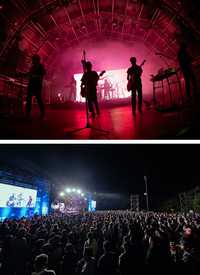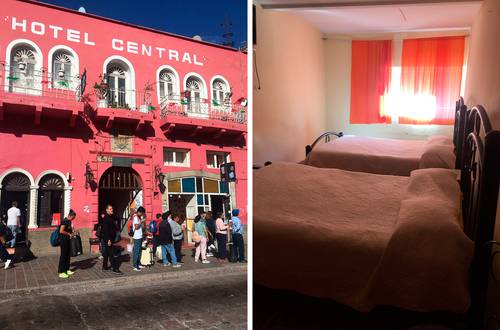Sonido Gallo Negro's psychedelic cumbia got everyone dancing in Los Pastitos.

Sonido Gallo Negro's psychedelic cumbia got everyone dancing in Los Pastitos.
Hernán Muleiro
Sent
La Jornada Newspaper, Saturday, October 18, 2025, p. 4
Guanajuato, Gto., a group with a strong presence at music festivals abroad, Sonido Gallo Negro combines cumbia with psychedelia and a dose of rock, achieving an original result that invites anyone who listens to it to dance.
At Los Pastitos, a regular venue at the International Cervantino Festival (FIC), the teenager instantly goes from the colloquial: “No way!” to “Would you allow me to dance to the next song?” The rapt audience cheers the group on with their hands in the air; they're playing a cover of Das Model, a song by the German band Kraftwerk, which in one of its Spanish versions was translated as follows: “She's a model and she loves to walk the runway. / She doesn't want to get off the catwalk. / She's a model and you can't touch her. / You can only reach her with a camera.”
The first cumbia version of the song was made by Chilean-German Uwe H. Schmidt, who uses the aliases Atom Tm and Señor Coconut.
Continuing with the feminine theme, the musicians of Sonido Gallo Negro continue with A Minha Menina, by the Brazilian group Os Mutantes, released on their eponymous 1968 album, perhaps the pinnacle of rock made in South America.
The original version features the beloved line: "He made the silver moon hide and the golden sun appear." It's a traditional love song, composed by Jorge Ben and the magnificent arranger Rogério Duprat, inspired by Smokey Robinson's "My Girl ."

▲ The band played some covers and classic tracks from their albums in their own style. Photo by Carlos Alvar / FIC
By this point in the performance, the audience's commitment is complete, fueled by the energy of the group; there's no dress or dance code, and that helps you avoid being so focused on each other's gaze. There's only a brief interlude in the Cervantes-like enjoyment when members of the police force intrude on the audience, searching for who knows what: What's the point of intruding on someone else's pleasure when there's no altercation going on? With no illicit activity to pursue, they take a selfie with a young audience member.
The performance of the group's thereminist and graphic designer, Dr. Alderete, was outstanding. It's curious to think that when Russian inventor Leon Theremin created the instrument that bears his name in 1920, cumbia was a musical style in its infancy.
The intensity doesn't let up when Sonido Gallo Negro focuses on their own compositions, ranging from the album Cumbia salvaje (2011) to Paganismo (2022). "It looks great from here," they observe from the stage.
Finally, they give in to the audience's requests and play several encores, including one that sounds like Secret Agent Man, by guitarist Johnny Rivers, a song about a secret agent who "probably won't live to see tomorrow."
Expert highlights Guanajuato's influence on Thomas Pynchon's Against the Day
For The Engineer Who Fled Out the Window, Franco Félix revisited the letters that the American author wrote during his time in this state.

▲ Facade of the Hotel Central in Guanajuato, and room 32, where the writer stayed. Photo by Hernán Muleiro
Hernán Muleiro
Sent
La Jornada Newspaper, Saturday, October 18, 2025, p. 5
Guanajuato, Gto., No crowd can obscure the wealth of mysteries Guanajuato holds. One of them is related to the visit of Thomas Ruggles Pynchon (1937, New York). Legend has it that the author, who never gave an interview and of whom almost no photographs are known, escaped through a window of his hotel room in Mexico City, pursued by a reporter and a photographer from The New York Times.
Both the interviewee, essayist and editor Franco Félix, and the interviewer had access to the letters of the famously enigmatic Thomas Pynchon during their visit to Mexico, following the release of V., his first and award-winning novel, published in 1963.
The correspondence is preserved in the Ransom Archive at the University of Texas at Austin; it consists of letters from Pynchon to a friend during his stay in Mexico.
They can be consulted individually, but they are subject to a strict ban on public dissemination, which Félix suffered after winning an essay prize analyzing the material: "They said they couldn't allow anything like that to be published, with their permission, because it would burst the dam, the containment barrier: everyone would want the same thing. In short, they told me no, to be fair to the other Pynchonians in the world.
“Of course, this discouraged me a lot, but I didn't sit idly by; so I transcribed and paraphrased the letters and pinned each one for anyone who wants to look at them. I mean, they can't sue me for telling everyone where to go to read their personal texts, right? It doesn't matter. It would be fun.”
This is the story of how the first version of Félix's book, The Engineer Who Fled Out the Window, winner of the Malcolm Lowry Fine Arts Award, remained unpublished.
“I celebrate your resignation from the public eye”
Despite the blow, Félix paraphrased the letters, and his interest remained unchanged: “The refusal didn't change my perspective on him; on the contrary, every day that passes, I celebrate his discretion and his withdrawal from the public eye more.”
Pynchon's letters are a glimpse into the author's mind, surprising for the wealth of information it absorbs, and even more recognizable for the way this information is translated with detail and credibility into his novels, without losing his narrative style even within extravagant plots. For Félix, "Pynchon already recognizes the strangeness of Mexico City, but this contact with the province, with a place further from the capital, connects him with a country that is even stranger and more labyrinthine, more colorful and alive," he says in the correspondence.
“He sees a Mexico with a different texture, and this, I imagine, shaped one of the most ambitious books of his career: Against the Day (2006), a novel that features Guanajuato, Zacatecas, Chihuahua, and so on. A very entertaining story, set between 1893, during the World's Columbian Exposition, and the end of the Mexican Revolution. I'm sure this trip to Guanajuato was fundamental to a good part of this book of enormous historical wisdom about our country and other places in the world.”
The Hotel Central in Guanajuato, located at 111 Benito Juárez Avenue, bears no mention of the author's stay. The room indicated in the correspondence, number 32, matches Pynchon's description of a window overlooking the street, which was much quieter at the time.
In movies and bookstores
In recent weeks, several unusual developments have emerged regarding the author: One Battle After Another, directed by Paul Thomas Anderson, is currently in Mexican theaters and is a loose adaptation of Vineland, his 1989 novel, starring Leonardo DiCaprio. The other good news for Pynchon fans was the publication of Shadow Ticket, a new novel that will be translated into Spanish in 2026.
The INAH locates a well-preserved city on Guerrero's Costa Chica
From the Editorial Staff
La Jornada Newspaper, Saturday, October 18, 2025, p. 5
Experts from the National Institute of Anthropology and History (INAH) recorded the Paso Temprano or Corral de Piedra site, a 1,200-year-old city that stands out for its high degree of conservation in the community of El Carmen, municipality of Xochistlahuaca, on the Costa Chica of Guerrero.
"In the coming years, their study could define a local archaeological culture that flourished between the Epiclassic and Early Postclassic periods," said archaeologist Miguel Pérez Negrete, who, along with Cuauhtémoc Reyes Álvarez, also affiliated with the INAH Center in the state, has conducted the inspection work.
He explained that the remains have been known for decades by the Nahuatl inhabitants of the area, who call the site Corral de Piedra or Ancient City. However, it is known that Amuzga and Mixtec populations occupied the area at the end of the pre-Hispanic era. Despite this, he says, more research is needed to determine who lived there.
The investigations will determine what they were seeking to protect themselves from, as the site was built in a strategic position, taking advantage of ridges and cliffs for defensive purposes, to which its pre-Columbian occupants added a wall.
The INAH explained that the remains are the remnants of a settlement more than 1.2 kilometers long, which had a stratified society, as evidenced by residential buildings at lower altitudes and palatial areas at higher elevations.
“At the summit is the extensive defensive sector delimited by a wall. From this point, passages bordered by gorges, checkpoints, and narrow corridors are common until reaching the ceremonial sector, which houses an I-shaped ball court. It is 49 meters long by 8 meters wide and has natural promontories at both ends of the forecourts, which were partially lined with stone walls,” Pérez explained.
He emphasized the area's state of conservation: "It's as if centuries hadn't passed. You can see what the homes, hallways, and the layout of spaces were like." The challenge, he concluded, "is to establish strategies to preserve it."
Meanwhile, the INAH emphasized that the work is supported by municipal commissioner Noé Salazar Maceda; deputy commissioner Roberto Guerrero González; director of the Xochistlahuaca Community Museum Cecilio Antonio Nieves; and local professor Domingo Torres Aparicio.
jornada





